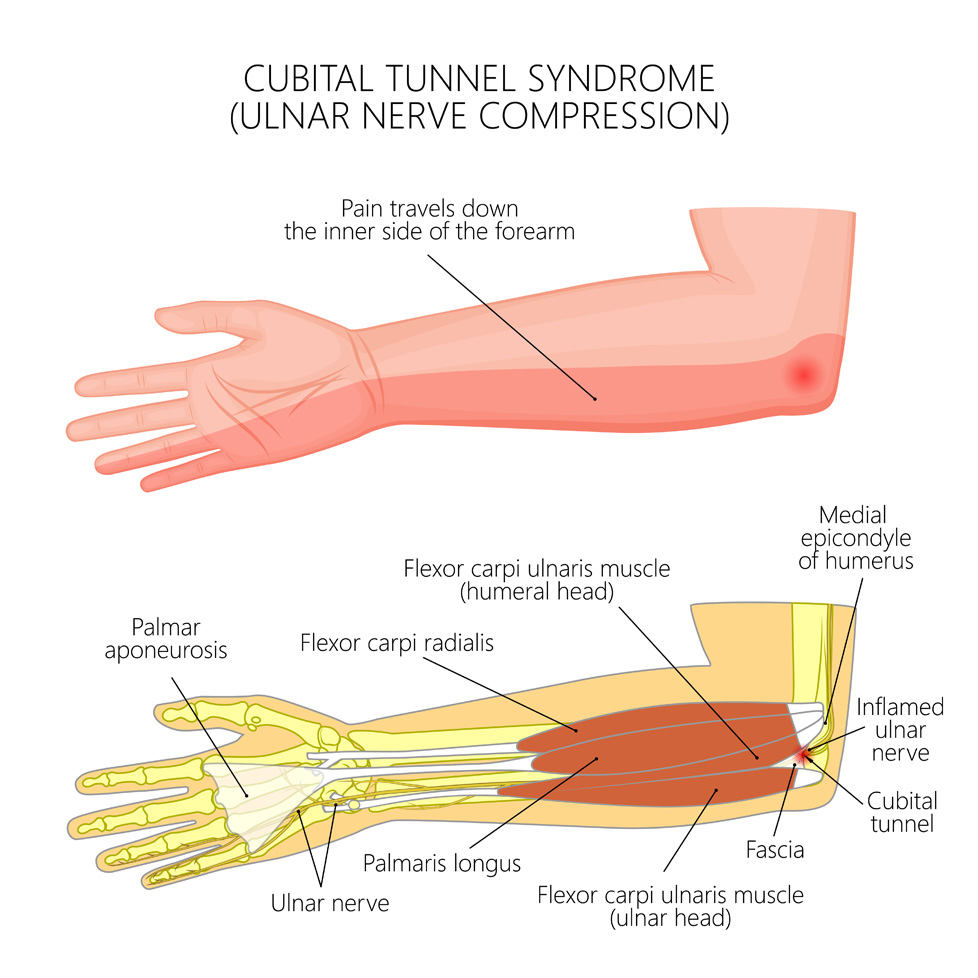What is Cubital Tunnel Syndrome?
Cubital tunnel syndrome is a condition that occurs when a nerve at the elbow (the ulnar nerve) is pinched or compressed as it travels through a tight space on the inside of the elbow called the cubital tunnel. This is similar to, but less common than, carpal tunnel syndrome, which occurs at the wrist.
Causes
Anything that causes increased swelling, pressure, or irritation within the cubital tunnel can cause cubital tunnel syndrome. Often the cubital tunnel only becomes tight enough to pinch the nerve when the elbow is flexed for a prolonged period, as often occurs during driving, sleep, or when holding a book or electronic device for reading. In most cases there is no obvious direct cause, but several factors and medical conditions have been associated with cubital tunnel syndrome, including:
- Prolonged elbow flexion (driving, sleeping, reading)
- Overuse or repetitive activities
- Diabetes, thyroid and rheumatoid diseases
- Swelling due to fractures or other acute injuries
- Excessively loose tissue around the nerve allowing for snapping of the nerve
Signs and symptoms
Symptoms of this condition can include:
- Pain, numbness, or tingling usually the small and ring fingers
- Weakness or clumsiness of the hand
- Symptoms that are often worse at night and with certain activities like driving, but over time can become constant
- Aching pain or snapping sensation on the inner portion of the elbow
Is there a test for cubital tunnel syndrome?
Yes! By talking with you about your symptoms and medical history, and examining your hand, we can detect most cases of cubital tunnel syndrome. If symptoms are severe or long-standing, we perform a nerve test to confirm the location of the pinched nerve and help guide further treatment.
Treatment
Nonoperative treatment:
- Activity modification recommendations
- Night-time elbow splinting
- Anti-inflammatory medications
Operative treatment:
In cases that are severe, long-standing, or have failed nonoperative treatment, a minor surgical procedure can often significantly improve symptoms. There are several options for the type of anesthesia and procedure, but the most common technique involves mild IV sedation, regional nerve block numbing of the arm, and a small incision on the inner portion of the elbow to relieve pressure around the ulnar nerve in the cubital tunnel.
Ready to confirm a diagnosis and fix the problem, or just want to learn more?
Our board-certified orthopedic hand and wrist surgeons, Eric Angermeier, MD and Kyle Kokko, MD, PhD, are here to help! They can often diagnose the problem in one visit, and get you started with a treatment plan. We offer a wide variety of both nonoperative and operative treatment options.
Call today for a clinic or telehealth appointment! 854-429-4263
